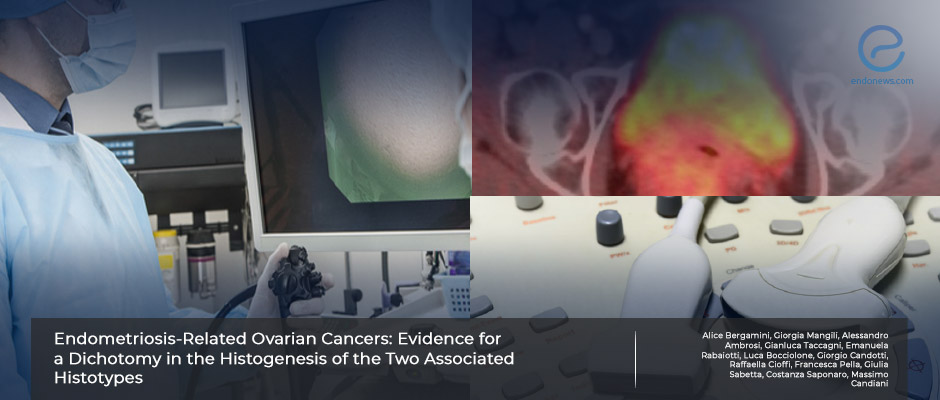Ovarian cancers arising in endometriosis: still an unresolved issue
Jul 25, 2023
Ovarian cancers arising in endometriosis need more sophisticated research
Key Points
Highlights:
- The association between endometriosis and ovarian cancer was first put forward in 1925 by Sampson and then confirmed in 1953 following observation of benign endometriosis tissue close to ovarian cancer.
- A systematic review and meta-analysis of ovarian cancers in 2021 revealed that clear cell and endometrioid cancer subtypes were more often associated with endometriosis.
Importance:
- Among endometriosis-associated ovarian cancers, detailed analysis of cancer subtypes reveals clues during slow development within endometriotic cysts so that early ultrasound detection could be possible.
What's done here:
- This is a retrospective study of 48 cases of ovarian cancers definitely associated with endometriosis, diagnosed and treated at Milan, Italy, for a time span of 21 years.
Key Results:
- Histogenesis, clinical behavior, and co-existence with endometriosis might be different for "pure clear cell ovarian cancer" and "mixed endometrioid–clear cell ovarian cancer" arising from endometriosis.
- Cancers with clear cell features seem to develop within an endometriotic cyst, yielding a possible early cancer detection by ultrasound imaging.
Limitations of the study:
- Due to the relatively small number of patients, the results should be interpreted with caution and need to be confirmed in further series.
- The separate investigation of clear cell and endometrioid ovarian tumors with and without associated endometriosis could be helpful in better defining the various clinicopathologic differences.
- The lack of molecular evaluation in these tumors, which could be helpful in better understanding carcinogenesis and its relationship with endometriosis is also another potential limitation in this research.
Lay Summary
Alice Bergamini and associates from San Raffaele Scientific Institute, Milan, Italy have published their results on clinicopathologic features of endometriosis-associated ovarian cancers in a recent issue of the journal “Diagnostics”.
The association between endometriosis and ovarian cancer was first noticed in 1925 by Sampson, and then, confirmed by Scott in 1953, following observation of benign endometriosis in proximity to ovarian cancer. Scientific studies confirmed that the epithelial ovarian cancers that are most closely related to endometriosis are endometrioid and clear cell subtypes. In fact, these neoplasms have mutations in common with endometriosis, such as PTEN, PIK3CA, KRAS, and ARID1A.
Detailed analysis of histopathologic subtypes among endometriosis-associated ovarian cancers may reveal clues during slow development within endometriotic cysts so that early ultrasound detections of malignant transformations could be possible.
Researchers conducted a retrospective study on 48 cases of ovarian cancers definitely associated with endometriosis, diagnosed, and also treated accordingly at the same institution, and treated accordingly. Among these 48 patients, 54% had "endometriosis-associated endometrioid ovarian cancer (EAEOC)" whereas 22(46%) had either pure clear cell ovarian cancer or mixed endometrioid–clear cell ovarian cancer arising from endometriosis (ECC). Bilaterality was significantly higher in the EAOEC group as well as a solid/cystic rate at gross pathology. Patients with ECC had a more advanced disease stage. A synchronous endometrial carcinoma was detected in 38% of EAEOC patients.
These results imply that histogenesis, clinical behavior, and co-existence with endometriosis might be different for pure clear cell ovarian cancer and mixed endometrioid–clear cell ovarian cancer arising from endometriosis, contrary to endometriosis-associated endometrioid cancer. Cancers with clear cell features seem to develop within an endometriotic cyst, yielding a possible early cancer detection by ultrasound examination.
However, there are several limitations in this research. First, due to the relatively small number of patients, the results should be interpreted with caution and need to be confirmed in further series.
The separate investigation of clear cell and endometrioid ovarian tumors with and without associated endometriosis could be helpful in better defining the various clinicopathologic differences. Finally, the absence of molecular features in these tumors, which might be helpful in better understanding carcinogenesis and its relationship with endometriosis is also another possible limitation in this research.
Research Source: https://pubmed.ncbi.nlm.nih.gov/37189525/
endometriosis ovarian cancer clear cell carcinoma endometrioid carcinoma

